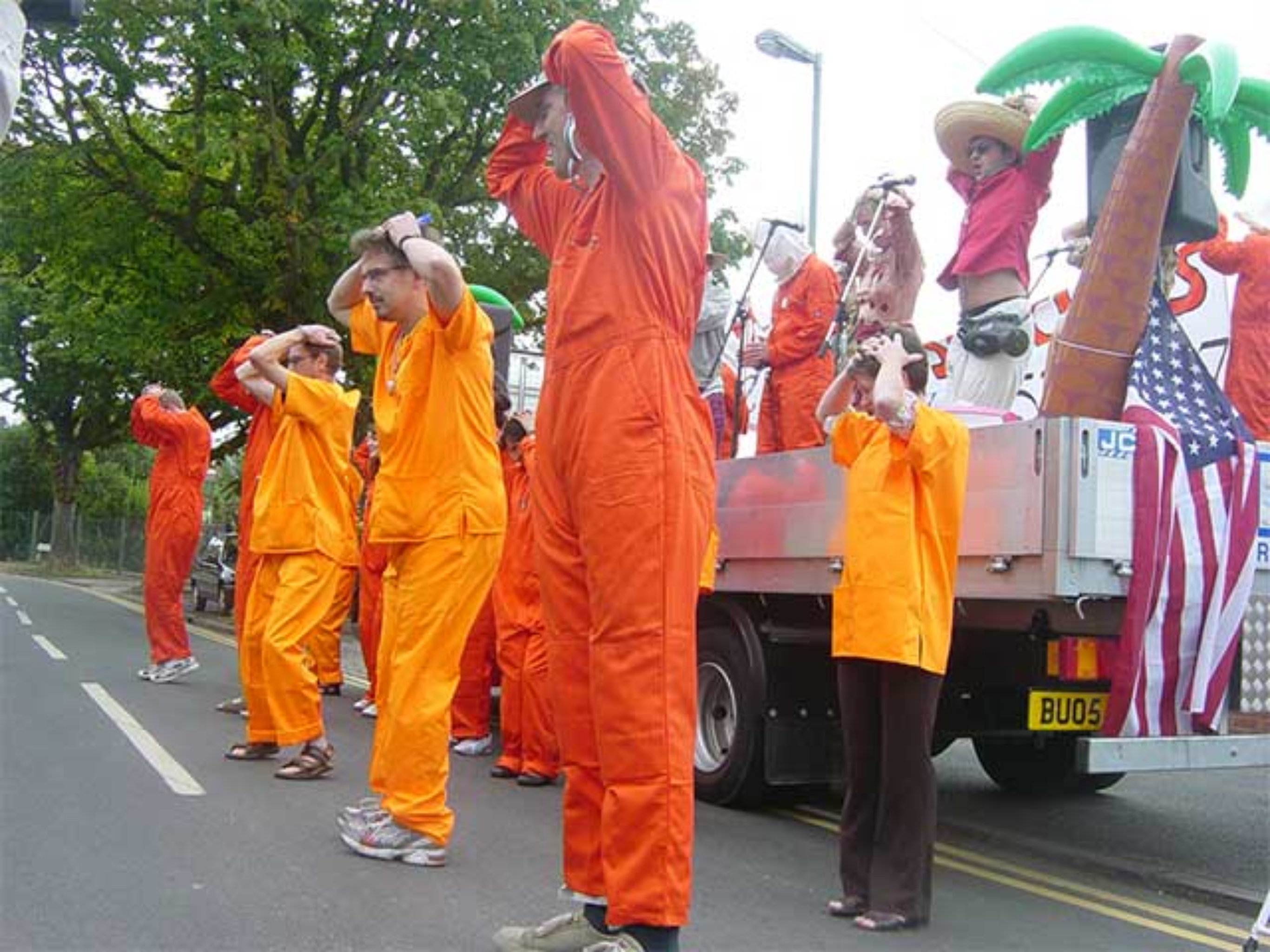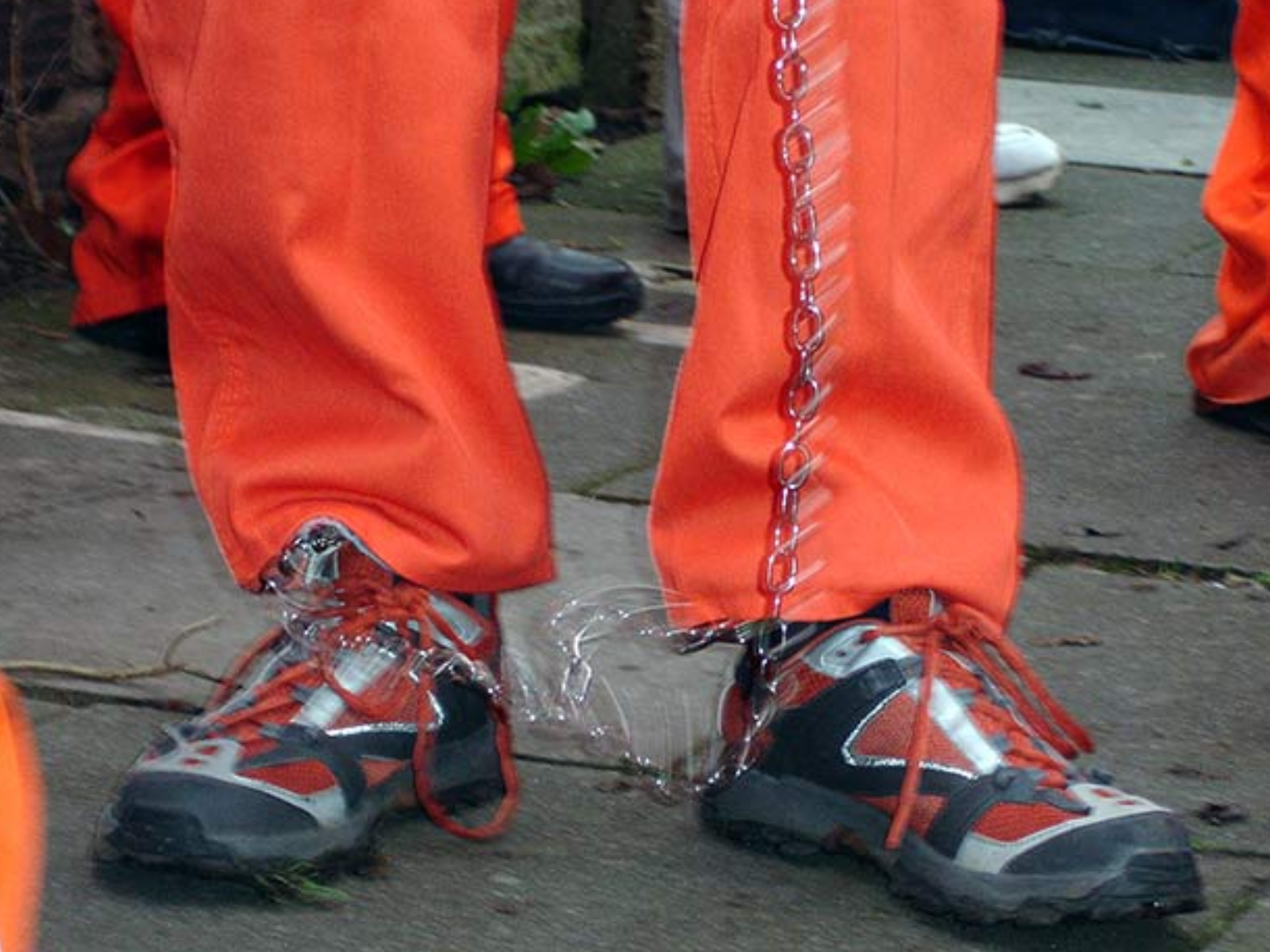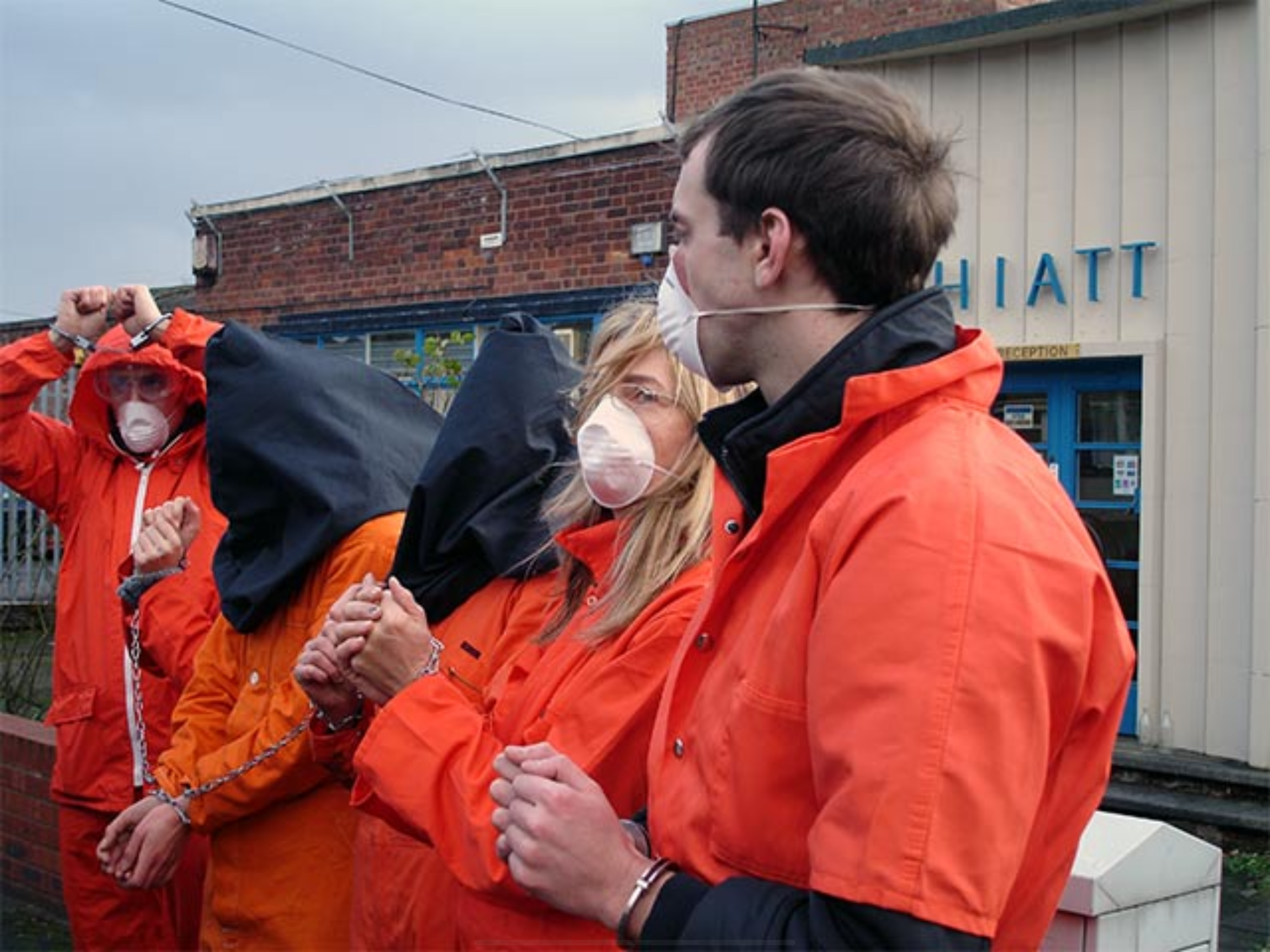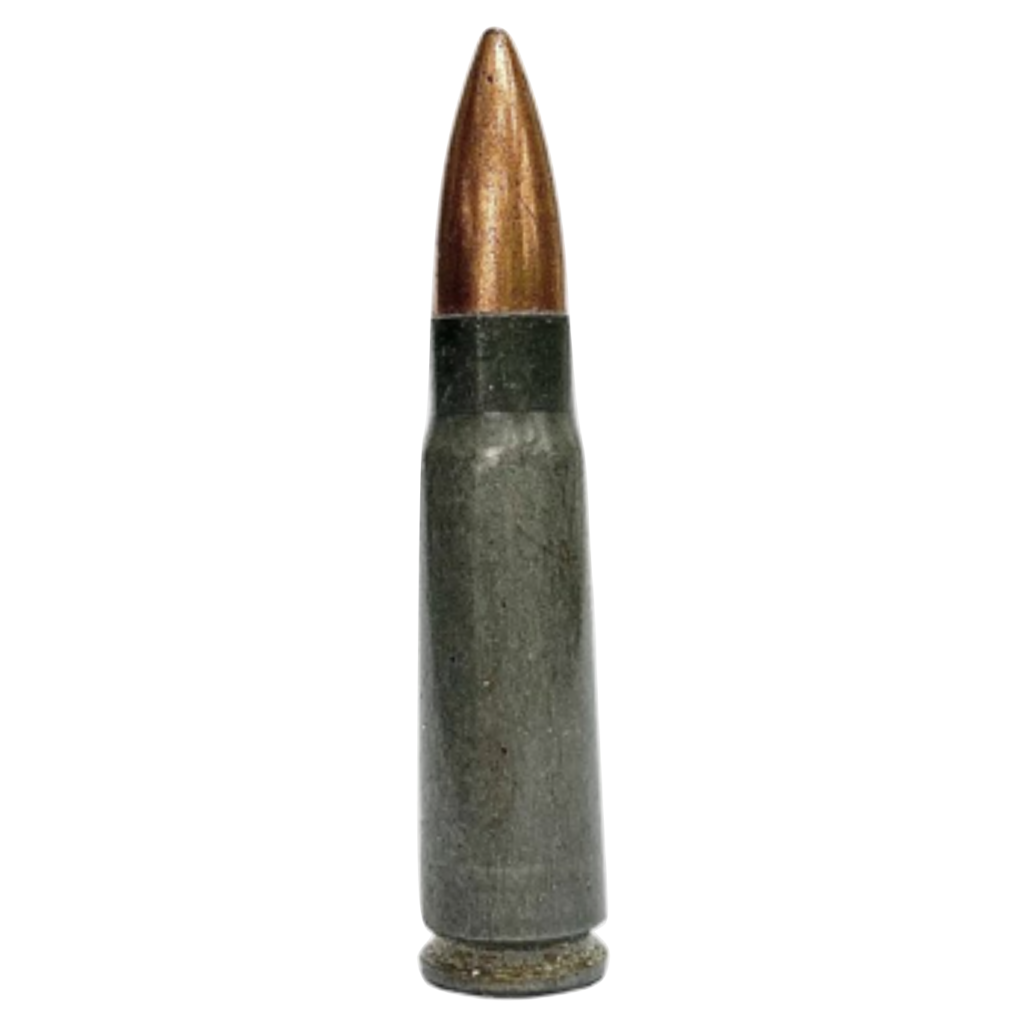
FEATURED EXAMPLES
Ilha das Flores
UDITA
Primark – on the rack
Girl model
Mangetout
From India’s ginger fields to the table
INGREDIENTS
INTENTIONS
Improve pay & conditions
Change consumer behaviour
Educate workers
TACTICS
Flip the script
Workers take the mic
Find the unions
Join with others
Encourage feminist solidarities
Find a character
Spend some time
Include suffering kids
Juxtapose extremes
Make it incomplete
Make Music
Encourage curiosity
Encourage detective work
Make it funny
RESPONSES
These people are inspiring
I’m humming that music
I laughed my ass off
I’m so angry
This is so sad
I just cried
This is disgusting
Creeperific
I get what it’s like
I gotta do something
IMPACTS
Now I know
Now we’re talking
I shop differently now
Audiences are empowered
“It’s funny how you can be so angry at someone who is just doing their job.”
By Katie Smart
IN BRIEF
Student Katie Smart has taken the ‘Geographies of material culture’ module at the University of Exeter. She’s been watching trade justice documentaries, analysing the comments on their followthethings.com pages, and making sense of them using a draft copy of ‘The followthethings.com handbook for trade justice activism’. She knows a thing or two about how trade justice documentaries work and what they can do. She imagines meeting a filmmaker who’s thinking of making one of these films for the first time. He’s called Dan. He asks if she can give him some advice. She guesses he wants to present the hardships of Global South workers to Global North audiences. To do this, you’ve got to make it relevant, choose your audience, engage the right emotions, and make it memorable, she says.
More about this page.
We are slowly piecing together a followthethings.com handbook for trade justice activism and are publishing draft pages here as we write them. This is an ‘advice’ page. The main text is an example of student work from the ‘Geographies of material culture’ module which followthethings.com CEO Ian ran at the University of Exeter in the 2024-25 academic year. Students watched 8 films, and read their pages on followthethings.com (with the expeption of an unfinished film called From India’s ginger fields to the table). They were asked to pair the comments brought together on each of the films’ followthethings.com pages with the appropriate ingredients phrases (naming their intentions, tactics, responses and impacts – show in bold below) being drafted for the Handbook. Using these phrases as a pattern language (see FAQs), students were tasked to work out how specific intentions (e.g. improve workers’ pay & conditions) needed specific tactics (e.g. flip the script) to generate different kinds of responses (e.g. this is disgusting), which could generate different kinds of impacts (e.g. audiences are empowered). [NB pages about each of these ingredients are coming soon] At the end of the module, students were asked to imagine that they had met someone who was about to make their first trade justice documentary. Drawing on what they had learned in the module, what advice could they give them on how to make it effective?
👋 Hiya Dan!
You want to make a trade justice documentary???
Well, from what I’ve learnt in a Trade Justice module this year, your goal should be achieving two key outcomes: A) improve workers’ pay and conditions in the Global South, and B) change consumer behaviour in the Global North. These objectives are intertwined and can be approached through targeted filmmaking strategies.
First: check out Duncombe’s (2023) book . It’s all about theories of change and will give you the tools you need to make your documentary as impactful as possible. There are two main strategies you can use to achieve both A and B:
For A – use a materialist theory of change-this means seizing the “means of production” (Duncombe, 2023, p. 265) – here you could focus on the workers’ control over their own labour in the Global South.
For B – go with an activist theory of change-targeting emotions to “stir up the masses” (Duncombe, 2023, p. 265).
I’ll walk you through how various techniques can be used to empower workers in the Global South and spark emotional engagement in the Global North, to drive social change in Trade Justice.
Stage 1: make it relevant
Before diving into audience specifics, think about how you can ensure its relevance to the social context. This worked for Ilha das Flores, cuz it appeared during Brazil’s “democratization period” (Trujillo in Pavalow, 2025, np). The filmmaker, Furtado, could capture social issues when the audience was receptive to them, so that he could make a doc about social injustices.
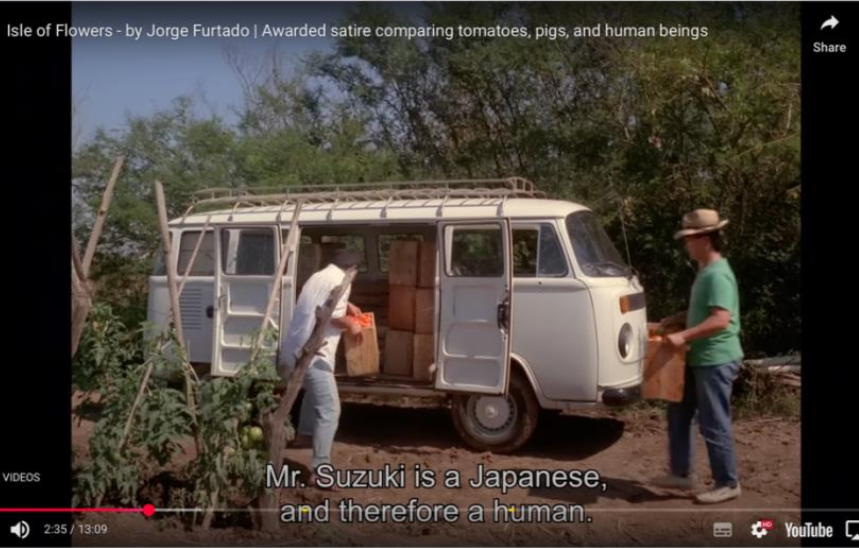
But relevance alone won’t make your documentary effective. For instance, if you wanted to make a doc about Global South trade injustices, a topic like Trump and his tariffs threatening global supply chains might have to be watered down to comply with regulations for mainstream TV. Ilha das Flores works cuz it breaks from convention. weird!!! Furtado made it funny. The line in the screenshot above is both hilarious (I laughed my ass off) and random. Furtado can make a serious point about capitalist exploitation while entertaining; “funny at first, demolishing in the end” (Trufó in Pavalow, 2025, np).
This is SO effective cuz humour sparks public discussion better than “serious or emotional appeals” (Morreall in Cameron, 2015, p. 278). Conversations about their own complicity in global capitalist systems. Now we’re talking. If you want your documentary to be impactful AND be picked up by mainstream TV, make it current and make it funny to highlight the absurdities in supply chains.
Stage 2: choose your audience
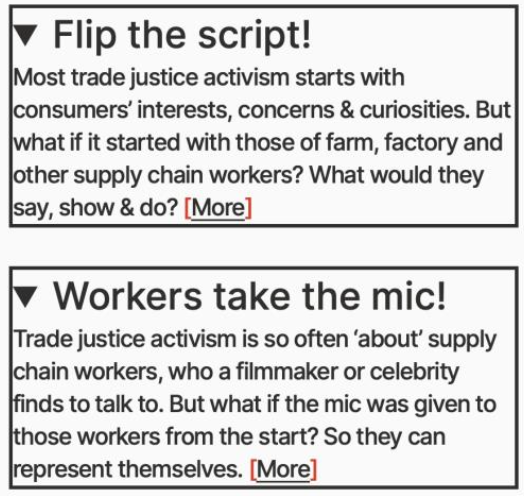
Now, decide who to engage, and how. If your intention is to educate workers and improve their pay and conditions in the Global South, centre the documentary on them. If workers see others fighting for their rights, they’re empowered to act.
Take UDITA, for example. The filmmakers flip the script and workers take the mic. Women, garment workers, and trade union activists are at the “centre of [the] film” (Anon in Barker et al., 2025, np), encouraging feminist solidarities.
As Duncombe (2023) speaks about in his Materialist Theory of Change, it is the material realities of workers’ lives that spur them into action. UDITA brings this theory to life; we see workers empower themselves – not just learning but fighting against “unsafe conditions” (Crawford in Barker et al 2025, np). The protagonist explains that five years ago the wage was $9/month; now it’s $68/month through campaigns. Your audience may resonate with unfairness and want to transform their own realities.
If you wanted to document the Bangladeshi protests over Trump’s tariffs, show what’s already happening to be effective for your intended audience. Show how material conditions, like uncertainty, are catalysts for organising. Find the unions, join with others that are already doing the same. Capture the “grassroots resistance” (Hoskins in Barker et al., 2025, np). YOU can help to apply pressure by documenting the ongoing struggle and building solidarity with these efforts.
In Bangladesh, document unions like the “National Garment Workers Federation” pushing for better conditions (Hoskins in Barker et al., 2025, np). Support the “Trade Justice Movement” of the Global South (Bannister and Bergan, 2023, p. 3). By showing workers that their fight can lead to change, they’ll think, “these people are inspiring”!! Audiences become empowered. The viewer could join a union themselves by seeing how collective bargaining can transform their realities.

BUT if your intention is to educate workers, are you sure they’ll even see the documentary? UDITA is on YouTube-accessible to anyone with a smartphone, which is lots of people nowadays. BUT … UDITA has low views. As Nora put it, “I’m so angry!!… UDITA needs more views!” (Nora in Barker et al., 2025, np). While it’s easy to make a doc accessible, getting the right people to watch it is a different challenge.
Primark – on the rack reached “4.2 million viewers” (Dowell in Adley et al., 2025, np). Good for awareness, BUT if your goal is to educate workers, think about “breadth” vs. “depth” (Duncombe, 2024, p. 71). Reaching millions is fine, but if they’re not the right people, impact is limited. Which are YOU aiming for?
Stage 3: engage the right emotions
If you choose to target a Global North audience, you need to think about how to engage them. You need to spark the right emotions- but avoid pity or sadness. From my Global North perspective, those emotions are passive and don’t drive real engagement.
Films like Girl Model and Primark – on the rack encourage empathy by:
Find a character -> spend some time -> include suffering kids
But does including children evoke the right emotions for activism (Brown and Pickerell, 2009)? Girl Model [left] shows “minors” in the exploitative modelling industry (Edelson in Hambly et al., 2025) …

while Primark – on the rack shows children working on garments (BBC Trust in Adley et al., 2025, np).
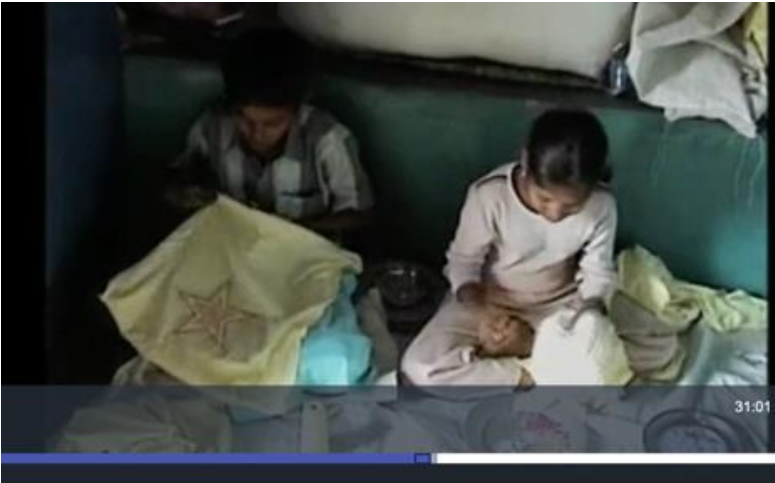
It’s hard not to feel something when you see children suffering, to empathise with their vulnerability, understand the world from their perspective (Krzanic, 2007). I was once young. The close-up shots help us to read their emotions too.
But empathy fades fast cuz the distance between myself, an able-bodied, privileged person-and these kids is huge!! I don’t get what it’s like. I’m feeling “for them” (Keen in Nåls, 2018, p. 145) not with them. Sympathy. Chouliaraki (2010) says victim-oriented campaigns turn the sufferer into an object we contemplate from afar. Us vs. Them. You can’t just show a victim, Dan, cuz look at the implications this has on Girl Model’s followthethings.com page: @DisturbedPixie, how is giving “Nadia a hug” (in Hambly et al., 2025, np) going to help in the grand scheme of activism? AWWWWWW. This is so sad. But sympathy can’t motivate action. Was I moved? Yes. Empowered? No. I just cried. I gotta do something. But what 🤔 ?
You HAVE to move emotions from “affective to æffective” (Duncombe, 2024, p. 46) – turning empathy into action. Otherwise, the film risks being an emotional spectacle without real impact.
So, Dan, evoke deep, “high-certainty” emotions, like anger and disgust (Kemp, 2025, p. 46), choose to shock and disrupt (Duncombe, 2024). How? Start by finding the right character. Shift your gaze from the teenage models to Ashley Arbaugh, the ex-model-turned-scout in Girl Model. She hides her camera to take non-consensual photos of girls. This is disgusting – creeperific.
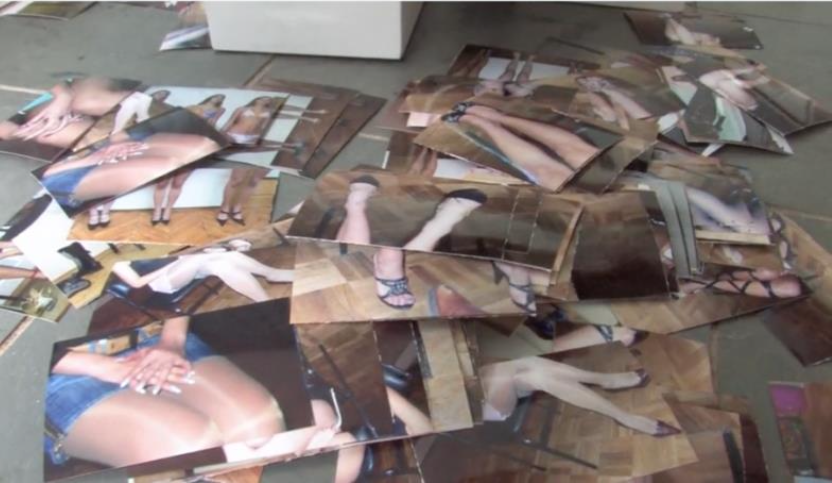
Disgust is “visceral” (Ryynänen et al., 2023, p. 3) – something you feel. Going beyond ‘AWWWW’ for these girls, it unsettles you. Just the thought of Ashley still makes me squirm 🤢. That’s how you make a documentary that matters. I feel it. It’s memorable. For me, now I know. Disgust makes me rethink my consumer habits and drives me to support ethical brands. Feeling disgust at exploitative practices means I can no longer ignore my complicity. I shop differently now. Want to apply this approach? Look for an exploitative figure in the Bangladeshi unions. Spend time with them. If you capture something that sparks disgust, it’ll engage your audience. It worked in Girl Model – give it a try!
Stage 4: make it memorable
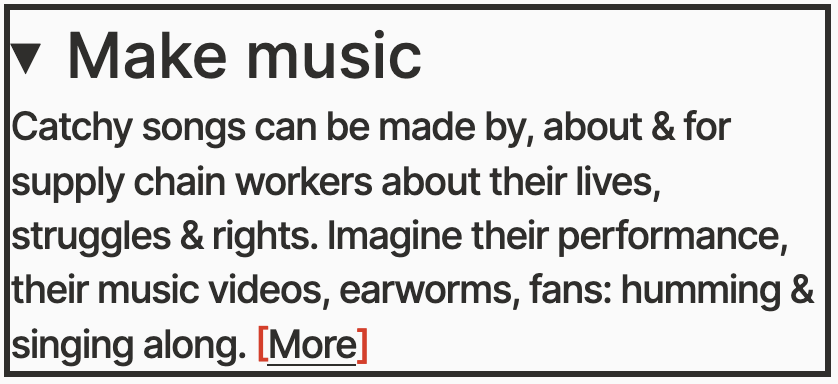
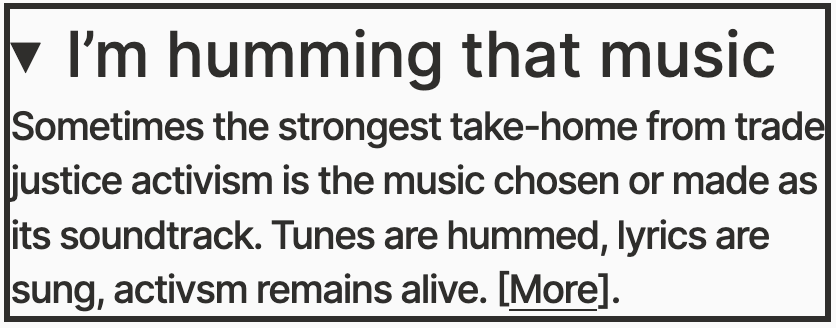
Another way to make it stick is to make it memorable. You could make music. I didn’t think ‘humming that music’ would be a response to Mangetout, which explores the journey of mangetout from Zimbabwe to a dinner party in London. But here I am months later, still remembering every word from the kids’ performance for Tesco’s inspectors 🎶 “Down the valley, up the mountain / Tesco’s our dear friend!” 🎶 (Holt in Cook et al., 2025, np).
The tune didn’t “stop in silence” (Williamson & Jilka, 2014, p. 653). It followed me home, reciting it at Easter. Cut from the performance…
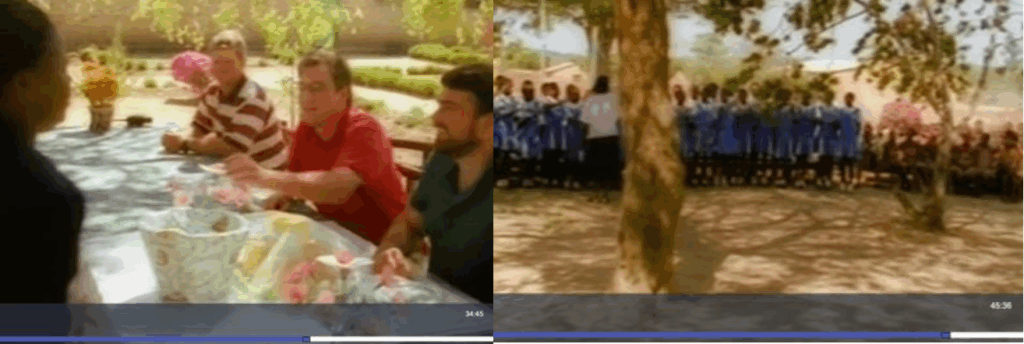
…to Grannie, “the farm’s ‘caterpillar examiner’ explaining how she tried to kill herself” 😱 (O’Malley in Cook at al., 2025, np):
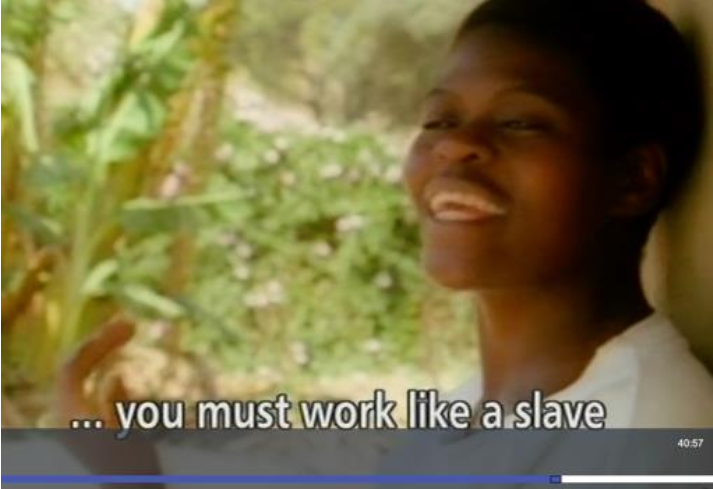
Not so sweet anymore, is it, @Tongue? Me singing happily to myself at home only reminds me more of the exploitation-the unease lingers as the song is lodged. I’m thinking about my role as a consumer. Clever…
Another tactic to make ur doc memorable is juxtaposing extremes of people. This works because viewers must work hard to understand why you chose these contrasts, and that effort makes the message stick. In Mangetout, produce buyer Mark Dady, “the great man from Tesco” (Holt in Cook et al., 2025, np), struts in, while the farmers he “bullied” (Aaronovitch in Cook et al., 2025, np) praise him. Girl Model too uses a glaring contrast between Nadya and Ashley, placed on “opposite ends of the business” (Smith in Hambly et al., 2025, np). One is a vulnerable girl exploited for profit, the other a scout capitalising on that vulnerability. It’s funny how you can be so angry at someone who is just doing their job. But the way their lives fit together is atrocious to the audience 😤. This tactic can evoke anger – I spoke about strong emotions earlier. The hope is that these spark action (Kemp, 2025).
You can also make it memorable by doing something different. You can make it incomplete / encourage curiosity. As Cook (2015) argues, the excitement of discovering things for ourselves fuels curiosity and critical questions. An interatcive documentary called From India’s ginger fields to the table by Bharath Ananthanarayana, did this. Ananthanarayana (in Ananthanarayana, 2025, np) wanted to encourage detective work 🕵️♀️. Like he had invented a game – Cluedo meets documentary. Two-minute clips where my classmates and I choose the sequence. Boje (in Connor and Phelan, 2013) developed an antenarrative approach, which Ananthanarayana uses. Through jumbled clips which unsettle “ordered narratives” (Connor and Phelan, 2013, p. 150), Ananthanarayana documents the many stories circulating within the narrative. My first clip was “Labouring the Field” (Ananthanarayana, 2025). One shot of digging , the only sound being the rhythmic thwack of labour.
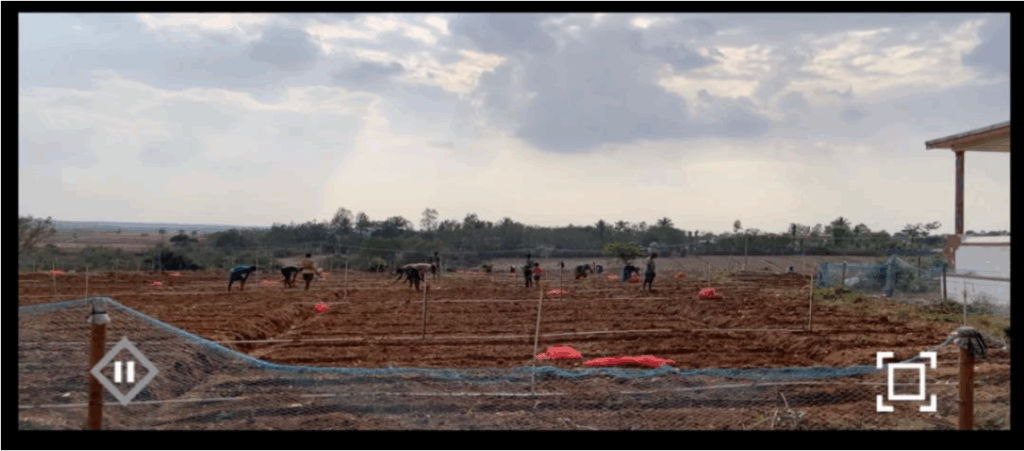
Then, I chose a sequence called “How It Began”. Wait-shouldn’t this have come first? Nope. Ananthanarayana hands the audience choice of how the story unfolds. That’s influential: just like how I have the power to create the story of documentary, I have the power to choose how I source commodities in my life. Dan, if you want people like me to feel that urgency of ‘I gotta do something’, you need to make them actively involved in the process – like Bharath did. Make them feel they have a part to play in changing the system.
By engaging the right emotions, you can create real impact. For me, I now know about the exploitation behind commodities like mangetout and girl models – that I had no clue about before. No longer ignorant. The deeper emotions inspired me to talk. Even this small step leads to change. Now we’re talking 🗣️ 💬. This is the impact you should aim for, Dan, cuz by sharing these films, the conversation passes through the “social realm” (Heim, 2003, p. 187), raising awareness and demystifying exploitation. Even by talking/singing to my dad about Mangetout, I’ve pushed the conversation outside “traditional art and activism worlds” (Duncombe, 2024, p. 74).
So, see what you can achieve for workers in the Global South and audience members in the Global North audience by thinking about all these things. Let me know what approach you decide to take!
SOURCES
Adley, K., Keeble, R., Russell, P., Stenholm, N., Strang, W. & Valo, T. (2025) Primark – on the rack. (followthethings.com/primark-on-the-rack.shtml last accessed 28 March 2025).
Ananthanarayana, B. (2025) Untitled [Q&A video & transcript], GEO3123: Geographies of material culture. University of Exeter.
Bannister, L. & Bergan, R. (2023) A timeline of UK trade and trade justice. London: Trade Justice Movement.
Barker, T., Collier, J., Baker, A., Coppen, L. & Eve, H. (2025) UDITA (ARISE). (followthethings.com/udita.shtml last accessed 28 March 2025).
+16 sources
Brown, G. & Pickerell, J. (2009) Space for emotion in the spaces of activism. Emotion, Space & Society, 2, 24–35.
Cameron, J. D. (2015) Can poverty be funny? The serious use of humour as a strategy of public engagement for global justice. Third World Quarterly, 36(2), 274-290
Chouliaraki, L. (2010) Post-humanitarianism: humanitarian communication beyond a politics of pity. International Journal of Cultural Studies, 3(2), 107–126.
Connor, T. & Phelan, L. (2013) Antenarrative and Transnational Labour Rights Activism: Making Sense of Complexity and Ambiguity in the Interaction between Global Social Movements and Global Corporations. Globalizations, 12(2), pp. 149–163
Cook, I. (2015) Be curious. Find out. Do something. European Year of Development (https://web.archive.org/web/20150402052050/https://europa.eu/eyd2015/en/fashion-revolution/posts/be-curious-find-out-do-something last accessed 10 April 2025)
Cook, I., et al. (2025) Mangetout. (followthethings.com/mange-tout.shtml last accessed 28 March 2025).
Duncombe, S. (2023) A theory of change for artistic activism. The Journal of Aesthetics & Art Criticism, 81, 260–268
Duncombe, S. (2024) Aeffect: The Affect and Effect of Artistic Activism. 1st ed. New York, NY: Fordham University Press.
Hambly, A., King, E., Keogh, A., Renny-Smith, C., Callow, E., Thorogood, J. & Alloy, V. (2025) Girl Model: The Truth Behind The Glamour (followthethings.com/girl- model.shtml last accessed 28 March 2025).
Heim, W. (2003) Slow activism: homelands, love & the lightbulb. Sociological Review, 51(2), pp. 183-202.
Kemp, D. (2025) Comparing disgust and sadness: examining the interaction of emotion & information in charity appeals. Journal of Social Marketing (online early).
Krznaric, R. (2007) Empathy & the Art of Living. Oxford: Blackbird.
Nåls, J. (2018) The difficulty of eliciting empathy in documentary. in Brylla, C. & Kramer, M. (eds.) Cognitive Theory and Documentary. Oxford: Palgrave Macmillan, p.135-148.
Pavalow, M. (2025) Ilha das Flores. (followthethings.com/ilhadasflores.html last accessed 28 March 2025).
Ryynänen, M., Kosonen, H. & Ylönen, S. (2023) From visceral to the aesthetic: tracing disgust in contemporary culture. in their (eds.) Cultural Approaches to Disgust and the Visceral. London: Routledge, p.3-16.
Williamson, V. & Jilka, S. (2014) Experiencing earworms: an interview study of involuntary musical imagery. Psychology of Music, 42(5), 653-670
Image credits
Conversation (https://thenounproject.com/icon/conversation-6769395/) by kliwir art from Noun Project (CC BY 3.0)
Ilha das Flores: credit Casa de Cinema de Porto Alegre
UDITA – credit Rainbow Collective
Primark on the rack: credit BBC.
Girl model: credit Carnivalesque Films
Mangetout: credit BBC
From India’s ginger fields to the table: credit Bharath Ananthanarayana
Handbook: credit followthethings.com
SECTION: advice
Written by Katie Smart, edited by Ian Cook (first published June 2025)


